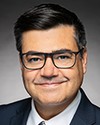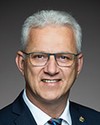Good morning, and thank you for giving me the opportunity to speak to you today.
In my opinion, moon shot programs can help Canada play a leading role on the global stage in areas of strategic importance. Over the next few minutes, I will outline some elements that I believe may help make moon shots successful, as well as some aspects to be wary of. These comments build on my experience participating in large-scale U.S., European and Canadian quantum research efforts.
First, curiosity-driven research is at the root of innovation. Had the founders of quantum physics focused on innovation rather than understanding the inner workings of nature at the atomic level, they would probably have devoted their efforts to improving the telegraph or candle wax. Had this been the case, technologies that have transformed society and whose development relied on quantum physics—such as computers, lasers and GPS—would not have been possible. In short, technological revolutions are founded on curiosity-driven research, and any moon shot program should reflect that.
Second, by definition, moon shots have ambitious, big-horizon objectives. The level and, importantly, duration of funding should reflect that.
An example of an existing program that does this well is the Canada first research excellence fund, or CFREF, which offers support over seven years. CFREF funding at the Université de Sherbrooke has been transformative. The seven-year duration of the support allowed us to put forward a long-term vision for the development of quantum science and technology, and to act on that vision.
Another characteristic I recommend moon shot programs to replicate is the flexibility of the funding. Indeed, with most funding opportunities, there is little room for new ideas on how to best use the funds once the grant starts. Large-scale and long-term initiatives should be given the latitude to make the most out of the allocated funds.
In the case of Sherbrooke's CFREF, this flexibility and the long-term nature of the program allowed us to take actions that led to the creation of the quantum science innovation zone in the Sherbrooke area to support Sherbrooke-based start-ups and attract companies from abroad. In short, it allowed the Institut quantique to have an impact well beyond producing excellent science. This was made possible thanks to the long duration of the funding and its flexibility.
Another lesson from this example is that supporting centres of excellence can lead to outsized impact. These centres help create the capacity to attract talent and rally the efforts of the broader research community so that we can deliver on ambitious projects.
Moon shots also mean making choices. To have an impact, moon shots should be based on Canadian issues and build on our strengths. Examples that come to mind are aging, biodiversity, climate change and quantum.
For quantum specifically, there are examples of moon shot programs in other countries from which we may get inspiration. In all cases that I am aware of, those programs were not prescriptive about the specific scientific and technological goals, which were instead left to be defined by the broad community of academic, industry and government players.
More generally, moon shots can help inspire the next generation of scientists and innovators. By supporting ambitious research projects, Canada can show young people how science and innovation are exciting and rewarding fields to work in and encourage them to pursue careers in these areas.
Let me now briefly mention a few aspects to be wary of.
First, funding opportunities typically focus on operations or infrastructure. Examples are CFREF, which funds operations, and CFI, which funds infrastructure. However, large-scale efforts need both. This should be baked into the program or, at the minimum, there should be coordination among funding agencies.
Moreover, international collaboration will certainly be important to any moon shot. It can be difficult for research money to flow across borders, but ways to incentivize key international players to actively contribute to these efforts should be built into these programs.
Attracting talent to Canada, including established researchers and students, is another important piece. However, despite the labour shortage, it seems to be getting more difficult rather than easier to do so.
Finally, training is a crucial piece. For example, it is a fact that we are not training enough students and post-docs in quantum science and technology. A quantum moon shot—and it's probably true of any moon shot—should support academic institutions in training more students and developing innovative programs to help create pipelines of capable talent that can meet the needs of moon shots, as well as the start-up ecosystem that will grow around these moon shots.
In summary, a moon shot program would help Canada remain at the forefront of science and technology. Moon shots should be based on Canadian issues and build on our strengths.
Flexibility and long-term support are crucial. Support to centres of excellence will help make these moon shots a success.
Thank you.




